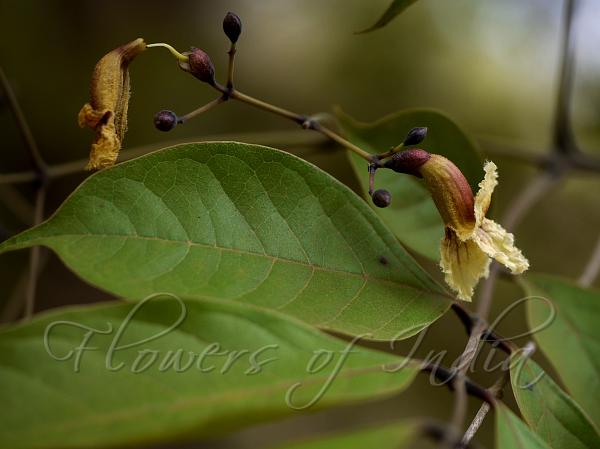|
| Yellow Snake Tree |
|

|

|
|
|
|
Photo: |
Botanical name: Stereospermum colais Family: Bignoniaceae (Jacaranda family)
Synonyms: Bignonia colais, Stereospermum tetragonum, Stereospermum personatum
Synonyms: Bignonia colais, Stereospermum tetragonum, Stereospermum personatum
Yellow Snake Tree is a deciduous tree, growing to 15-20 m tall, with the
trunk 15-25 cm in diameter. Large pinnate leaves are 25-50 cm long. Elliptic
leaflets, 3-6 on each side of midrib, are 8-14 X 2.5-6 cm. Flowers are pale
yellow, with reddish-purple veins, slightly curved, about 2 cm long. Upper lip is 2-lobed, and the lower
one 3-lobed, velvety at the mouth. The fruit is long, 4-angular,
curved, 30-70 cm, about 1 cm in diameter, brown, covered with white specks.
The Padiri (Tamil name) tree is associated with the Padaleeshwarar temple at
Tiruppathiripuliyur, Tamil Nadu. It is believed that Goddess Uma reached
Tiruppathiripuliyur after worship of 1008 Shiva sthalams. She worshipped Lord
Padaleeshwarar installed under a Padiri tree. After years of penance, Lord
Shiva appeared and he united with the Goddess under the sacred Padiri tree,
which is now the sthalavriksha of the temple.The tree is associated with the
Ekapatala, sister of Goddess Uma who took only one Patala leaf for food.
Flowering: May-July.
| Identification credit: Dinesh Valke | Photographed at Tungareshwar Wildlife Sanctuary, Maharashtra. |
• Is this flower misidentified? If yes,